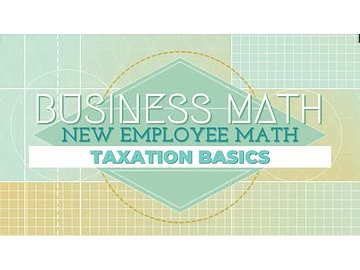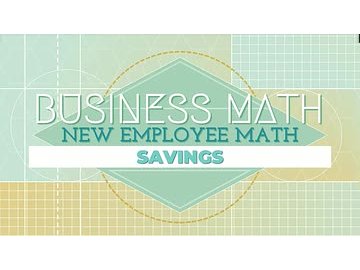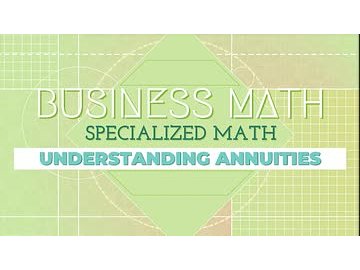Introduction to Math: Fighting the Fear
If you took math in high school or college, you probably reached a point where you thought, "When am I ever going to use this?" Well, in the business world, you might be surprised by how often you do use math. If you didn't enjoy math back in school, and especially if you struggled with it, this may seem intimidating. In this course, we're going to help with that. We'll discuss how math is important in business and discuss strategies for overcoming your fears.
Introduction to Math: Adding and Subtracting
Addition and subtraction are the most commonly used math operations in our daily lives, so it's important to understand how perform them. In this course, we're going to go over common terms, as well as how to do basic addition and subtraction.
Introduction to Math: Choosing the Right Operation
Once you've finished with school, most of the math problems you encounter will likely come in the form of word problems. In word problems, you're not told explicitly how to solve them. Instead, you have to use the clues given to you in the words that make up the
problem itself. In this program, we'll learn what sort of words to look for to help you choose the right operation to successfully solve the problem.
Introduction to Math: Estimation Basics
On a daily basis, you may come across many times when you don't need an exact number to a mathematical equation. When you're mentally calculating a grocery bill so you don't go over budget, or when you're rounding a tip for your server at a restaurant, what you're doing is called estimating. In this course, we'll take a look at how to estimate and when you might need it in business.
Introduction to Math: Finding Averages
When we talk about finding averages, we're usually talking about one of three different values: mean, median, or mode. We use these averages to find out what's normal, so we can make predictions about what's going to happen again or compare what's happening now to what's happened in the past. In this program, we're going to talk about what the three types are, as well as how and why to calculate each one of them.
Introduction to Math: Inequalities
In this program, we're going to discuss inequalities and comparing numbers in terms of being greater than or less than one another.
Introduction to Math: Multiplying and Dividing
Did you ever have to memorize times tables in elementary school? If so, you may or may not be a huge fan of multiplication and division. But the truth is, it's a quick way to add groups of numbers together or to separate a group into even subgroups. In this program, we'll learn the terms used to talk about multiplication and division, as well as strategies to help you master equations.
Introduction to Math: Positive and Negative Numbers
In this program, we're going to discuss what positive and negative numbers are and how they're used, so you can get more comfortable with both the concept and practical applications.
Introduction to Math: Understanding Decimals
If you've taken our course on fractions, you already understand what happens when an equation doesn't end with a whole number. In this program, we're going to talk about an alternative to fractions called decimals. By the end of our lesson, you'll know what they are and how to use them.
Introduction to Math: Understanding Fractions
In math, we often deal in whole numbers. But what happens when things don't end up quite even? What do we do with a remainder in division? Perhaps more importantly, how do we split up that extra slice of pizza? In this course, we'll talk about how to do just that, with a type of number called a fraction. First, we'll define the parts of a fraction, and then we'll talk about how we can use them.
Introduction to Math: Understanding Percentages
Fractions and decimals are both ways to express parts of a whole. In this program, we'll talk about one more way: percentages. By the time we've finished today, you'll know what percentages are and how to use them.
Introduction to Math: Understanding the Metric System
In the United States, we typically use the English or Imperial system of measurement for everyday purposes, but in most other countries around the world, the metric system of measurement is the standard. Because of this, the metric system is being used more and more often here in the States, so it's vital that you understand it and know how to use it. In this program, we'll go over basic vocabulary and definitions, as well as some common conversions between the Imperial and metric systems.
New Employee Math: Investment Basics
If you want to put your money to work for you, investing is the way to go. There's a risk/reward level out there for just about everyone, but it's important to have a solid foundation of how investing works before you get started. We'll cover basic types of investment, as well as the easiest ways to start investing, no matter what your income or experience level.
New Employee Math: Retirement Savings Basics
If you've been in the workforce for any length of time, odds are you might have daydreamed once or twice about retirement. Unless you plan to work for your entire life, the earlier you start planning and saving for retirement, the better. Today, we'll cover the basics to help set you on that path, including the following topics: Social Security, 401(k)s, Individual Retirement Accounts (IRAs), and Roth IRAs.
New Employee Math: Taxation Basics
Taxes serve a very important purpose in society. We all pay taxes in some way, shape, or form, whether it's income tax from our paychecks, property taxes on our homes or automobiles, or sales tax on items we purchase. These taxes all go to fund initiatives for the greater good, including schools, roads, libraries, and government operations. In this course, we'll focus mostly on income tax. There are two types of income tax: earned income tax and unearned income tax. Each is taxed at different rates at federal, state, and local levels.
New Employee Math: Savings
In this course, we'll discuss the four basic types of savings accounts and some strategies to help you build your savings one paycheck at a time.
New Employee Math: Your First Paycheck
There's nothing quite like the thrill of your first paycheck. It's easy to let your eyes zoom in
on that amount going into your checking account and nothing else. But it's a better idea
to look at the rest of those numbers on your paystub, so you know where each and every
penny you earned is going. That's what we're going to cover in this course.
New Employee Math: Budgeting Basics
Your paycheck is only as powerful as your intentions on how to spend it. That's why we're going to discuss some budgeting strategies to help you make the most of every penny you earn.
New Employee Math: How to Fill out a W-4
You've been offered a job, negotiated your salary and benefits, and now you've accepted! Next comes the paperwork. One of the forms you can expect to fill out for any U.S.-based job is the IRS Form W-4. Upon first glance, this form can look pretty complicated. In this course, we'll try to simplify it by walking through it together.
Job Offer Math: Understanding a Job Offer
Not all job offers are created equal. There are many factors to consider when determining whether a job offer is fiscally appropriate for your life. In this course, we'll go over the main components that comprise the total compensation package, in other words, what you'll be getting in exchange for your time and expertise. We'll also go over some other non-compensation elements that go into evaluating a job offer.
Job Offer Math: Benefits by the Numbers
When you look at your pay stub, your eyes likely go directly to the amount that ends up in your checking account, followed by the amount you pay in taxes, followed by any deductions related to healthcare, insurance, or investment plans. But there's one amount that's missing from the net pay or even the gross pay listed, and that's the value of your employer benefits. In this course, we're going to take you through several common employee benefits and the dollar amount attached.
Job Offer Math: Cost of Living Comparisons
If you've ever taken a good look at your budget, you probably know how much money you need to make in order to afford the life you have. But if you're entering a new geographic market, or even thinking about it, it's important to understand that your salary may translate to a very different way of life compared to what you're used to. In this course, we discuss the best way to determine the average cost of living for wherever you end up.
Job Offer Math: Medical Insurance Basics
There's no doubt about it, health insurance can be complicated. This course is designed to help you better understand the basics of health insurance. We'll go over key terms, different kinds of insurance, and some points of consideration when looking at different plans.
Specialized Math: Understanding Ratios, Proportions, and Percentages
Ratios, proportions, and percentages are all methods of comparing data. In this program, we'll define each one and discuss their purposes.
Specialized Math: Mark-ups and Mark-downs
In the world of marketing, one of the most important skills is understanding mark-ups and mark-downs. These two factors help determine potential for profits and drive potential sales. After watching this course, you'll understand how to calculate mark-ups and mark-downs to maximize profits.
Specialized Math: Calculating Production Costs
For businesses that sell products, knowing how to calculate the cost associated with creating those products is a vital part of understanding how to reduce costs and maximize profits. Here we'll cover the two kinds of production costs: fixed costs and variable costs. Then we'll use that information to calculate unit costs and do a break-even analysis.
Specialized Math: Compound vs. Simple Interest
Whether you're saving money or paying down a loan, understanding interest is a vital part of making informed financial decisions. In this program, you can learn how to calculate both simple and compound interest, so you're prepared for both scenarios.
Specialized Math: Determining Pricing
Figuring out what to charge for your products is one of the most important parts of running a successful business. If your price is too high, your sales will suffer. If you underprice your products, you won't earn as much money as you should, and you'll sacrifice potential for growth. In this program, you will learn effective strategies for pricing your products.
Specialized Math: Interest Rates
If you've ever had a savings account or taken out a mortgage to buy a home, you're probably familiar with the term "interest." In this program, we're going to discuss interest and interest rates. We'll cover how interest rates are determined, and how they can impact the economy.
Specialized Math: Inventory Basics
When it comes to running a business, one of the most important tasks is inventory management. Here, you'll learn the components of managing inventory and some strategies for carrying them out.
Specialized Math: Net vs. Gross
Whether we're talking about our paychecks or how much a business makes in profit, there's often a difference between the initial amount made and what we get to keep. In this program, you'll learn the difference between gross and net, and what it means when it comes to employee paychecks, as well as business income.
Specialized Math: Payroll Basics
For many employees, one of the major motivations for showing up to work is getting paid. The responsibility of making sure everyone gets paid on time and the correct amounts is called payroll. In this course, we'll discuss the basics of payroll, including setting pay periods and pay dates, dealing with taxes, timekeeping, and ensuring payroll is being done according to federal, state, and local laws.
Specialized Math: Understanding Annuities
The thought of being guaranteed income for the rest of your life probably sounds appealing. And at their most basic definition, that's exactly what annuities provide. But, as with most things, it's not quite that simple. In this program, we'll go over what annuities are and how they work.
Specialized Math: Understanding Loans
Sometimes in life we encounter situations where we need a little more cash than we have on hand. Whether it's to buy a car or a house or to make a large purchase, when we take advantage of the availability of someone else's money for a set period of time, it's called a loan. In this course, we're going to learn how loans work so you can make informed decisions about when it's wise to take out a loan and when it's not.
Specialized Math: Understanding Profits and Profit Margins
When it comes to judging the success of a business, how much money it makes is one of the key factors. But there's a lot more that goes into determining how successful or viable a business is. In this program, we're going to look at two of those measures: profits and profit margins.
Specialized Math: Understanding ROI
In business, as in life, sometimes we have to give a little to get something back. At its simplest, that's what a return on investment, or ROI, is. In this program, we'll discuss how to calculate ROI, what the limitations of ROI are when comparing the profitability of investments, and using rate of return.
Statistics: Introduction to Statistics
Statistics is the science of collecting, organizing, and analyzing data. This series will give you a foundation for using statistics to find meaningful information in numbers. In this first course, we're going to start with the basics and define some important statistical terms.
Statistics: Understanding Probability
Probability, at its essence, is how likely or not an event is to occur. If you've ever flipped a coin, you've dabbled in probability. In this program, we'll learn about the basic principles of probability, including the formula for calculating a given event's probability, how independent and dependent events affect probability, and how to calculate the number of outcomes for different kinds of sampling.
Statistics: Organizing Data
Collecting data using sound, strategic methods is vital to doing effective research. But without strategies in place for organizing that data, you won't be able to interpret or communicate the story your data is telling, and that makes it essentially useless. In this course, we'll learn how to avoid such a scenario by going over terminology and principles for organizing data.
Statistics: Data Analysis Basics
When something starts going wrong at work, you don't want to just throw metaphorical spaghetti at a wall, hoping a solution sticks. No, you need to follow a methodical process that defines the problem, hypothesizes causes, collects and analyzes information, identifies solutions, and tests them. In short, you need data analysis. In this program, we're going to cover the basics so you can solve problems at work quickly and efficiently.










































